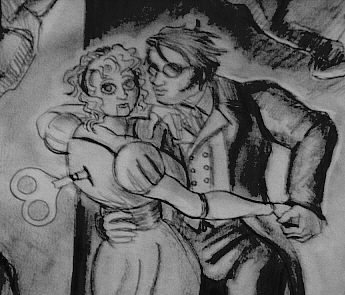Sunday, November 11, 2007
E.T.A. Hoffmann and the Real Girl
I've been listening to the opera, Les Contes d'Hoffmann, pretty obsessively over the last week. I've listened to three versions (two with Placido Domingo in the title role) and I've looked at some YouTube videos of the Kleinzach and Olympia arias. I'm no opera buff, but I think the music is beautiful -- so beautiful it almost makes me want to cry, if that makes any sense. Also, I love the story. It alternates between comic and tragic, and overall the tone is gothic, creepy, and disturbing. If you get the chance, you should rent the Michael Powell film of it, "The Tales of Hoffmann." It's vastly entertaining, and packed with imagery the MST3K guys would call "good old fashioned nightmare fuel." (George Romero has been quoted as saying it's his favorite movie.)
I thought it would be fun to do paintings of Hoffman and his unlucky love affairs. But before I get started on the paintings -- which could be a while -- I want to do some studies, so I can settle on a composition. This is a pencil drawing of Hoffmann and his first love, the mechanical doll, Olympia. Hoffmann, the poor dumb dope, doesn't realize she's a robot because he's been sold spectacles which -- unknown to himself -- make her appear to be a living person. Olympia's "father", Spalanzani, plans to use Hoffmann's infatuation with Olympia to fleece him of all his money. Hoffmann's dance with Olympia ends with the mechanical woman going haywire and flinging him about the room. His spectacles get smashed, and he recovers his senses just in time to witness Olympia getting torn apart by Spalanzani's disgruntled business partner, Dr. Coppelius. (That's Coppelius lurking in the background, in the nifty bicorn hat.)
I always enjoy doing research for my artwork, and this was no exception. For starters, I wanted the costumes to be contemporaneous with the real E.T.A. Hoffmann , who was born in 1776. In the "Olympia" sequence of "Les Contes d'Hoffmann", he's a traveling student, looking for a scientist to whom he can apprentice himself. My guess was, that meant that he was around twenty. Ultimately, the fashions I chose for both Hoffmann and Olympia wound up being more appropriate for the early 1800's, instead of the early 1790's. That was close enough, I figured, especially considering that a lot of opera companies set the sequence in the 1830's or later.
Olympia's gown is based on a "fashion plate" of that period that I found online. I eschewed styles with longer sleeves, because they didn't make Olympia look "girlish" enough. Since Spalanzani tries to pass Olympia off as both his daughter and as a suitable mate for Hoffmann, my guess is that she's meant to look like she's in her mid-to-late teens. Both her dress and hairstyle are inspired by ancient Greece, which was the style back then. Happily, the Greek look compliments her name.
Hoffmann's outfit is based on one worn by Hugh Grant in the movie "Sense and Sensibility." According to one costume website I visited, it's a conservative look for the time (around 1800). I love how the sleeves extend partially over the hands. Timewise, this outfit is probably a few years older -- at least! -- than Olympia's. And that suits me just fine. I figure Hoffman wouldn't be a rake, but merely a poor, wandering student who's found himself in another country. Similarly, Hoffmann's hair is unkempt and a bit spiky, since he'd only spend money for a haircut every so often. It's an intentional contrast with Olympia's elaborate curls. Hoffman's glasses are more like goggles than the rectangular, "Ben Franklin" style shades a man would have worn back then. This is also intentional. I like the shape of them better, and they have more of a jarring, sci-fi feel to them, which is the effect I want. Incidentally, one minor defect of Powell's film is the whacked-out, Elton John-style glasses Hoffmann wears -- they're so ridiculous, they make it hard to take Hoffmann seriously as a romantic hero. Seriously -- there's this one close-up where actor Robert Rounseville's pudgy, Vincent D'Onofrio-like face is all aglow with delight and surprise, and with the crazy glasses on, he's the Ghost of Charles Nelson Reilly Future. It's uncanny.
I wanted to keep the background simple, like a Toulouse-Lautrec poster or a Pre-Raphaelite painting. I decided to swipe -- er, borrow the drapery from a painting of Louis XVI. The wall directly behind Hoffmann and Olympia will definitely extend downward a little more in the next version of this that I do, so that it doesn't line up exactly with the wall in the background.
I'm pretty busy at the moment, so I don't know just when I'll be able to work on a painting of this subject, but I feel like I now at least have a good basis for it.
Subscribe to:
Post Comments (Atom)



1 comment:
It's a great drawing - i love his vital sexual energy towards her.
it's so modern, in spite of the romantic clothing.
I too love this story about the "unheimliche/heimliche"
Kind regards Helle H.
Post a Comment